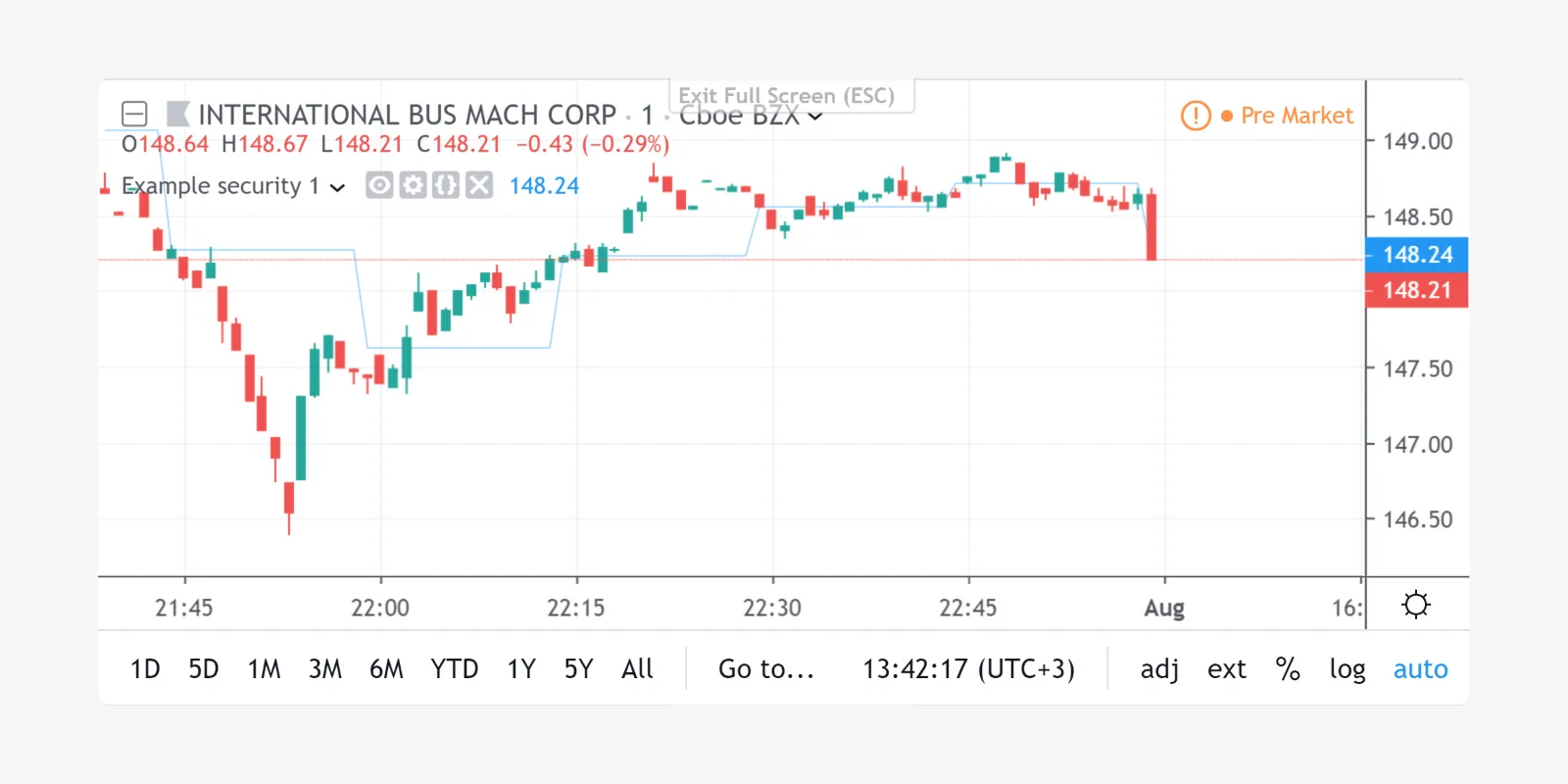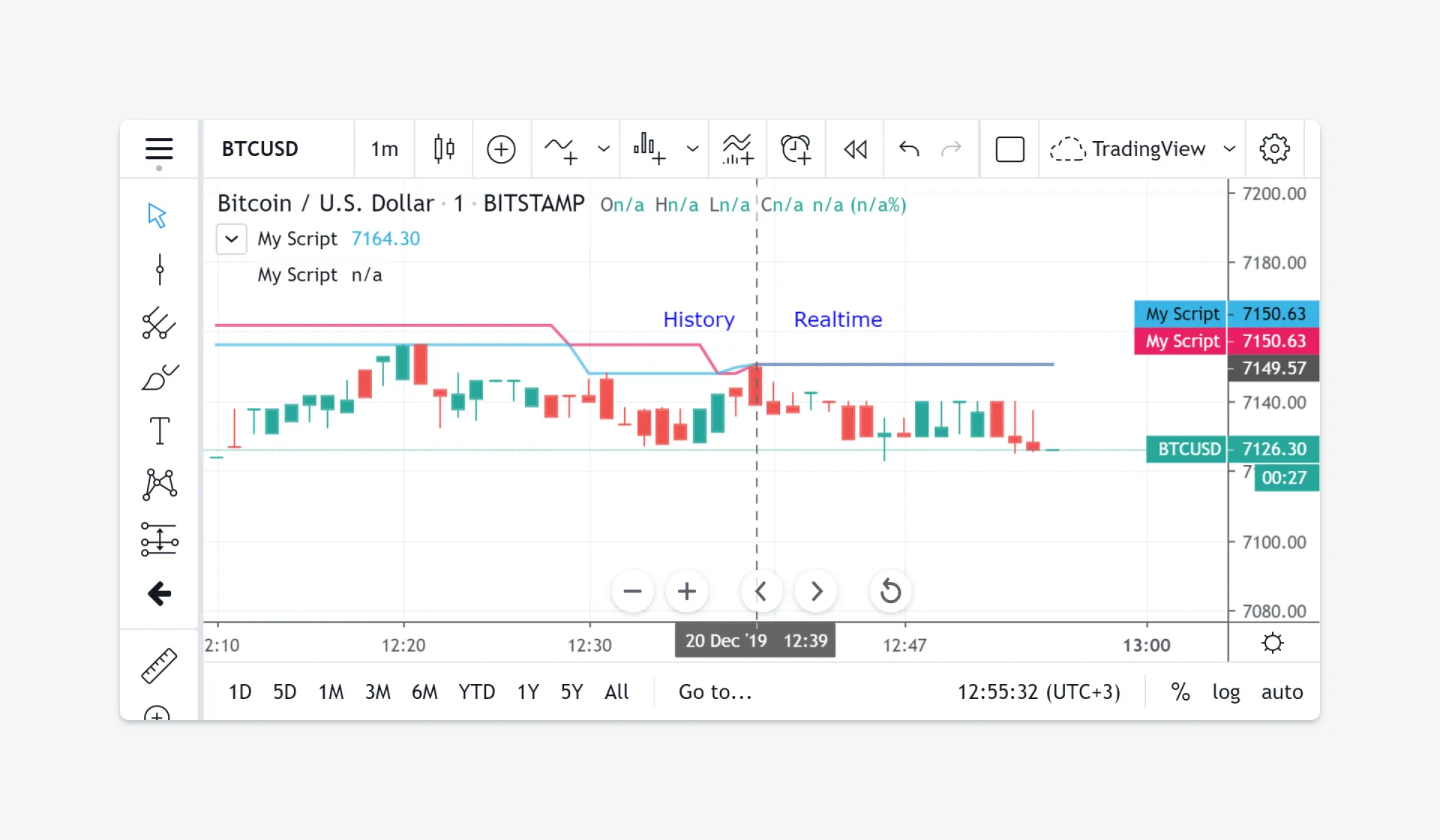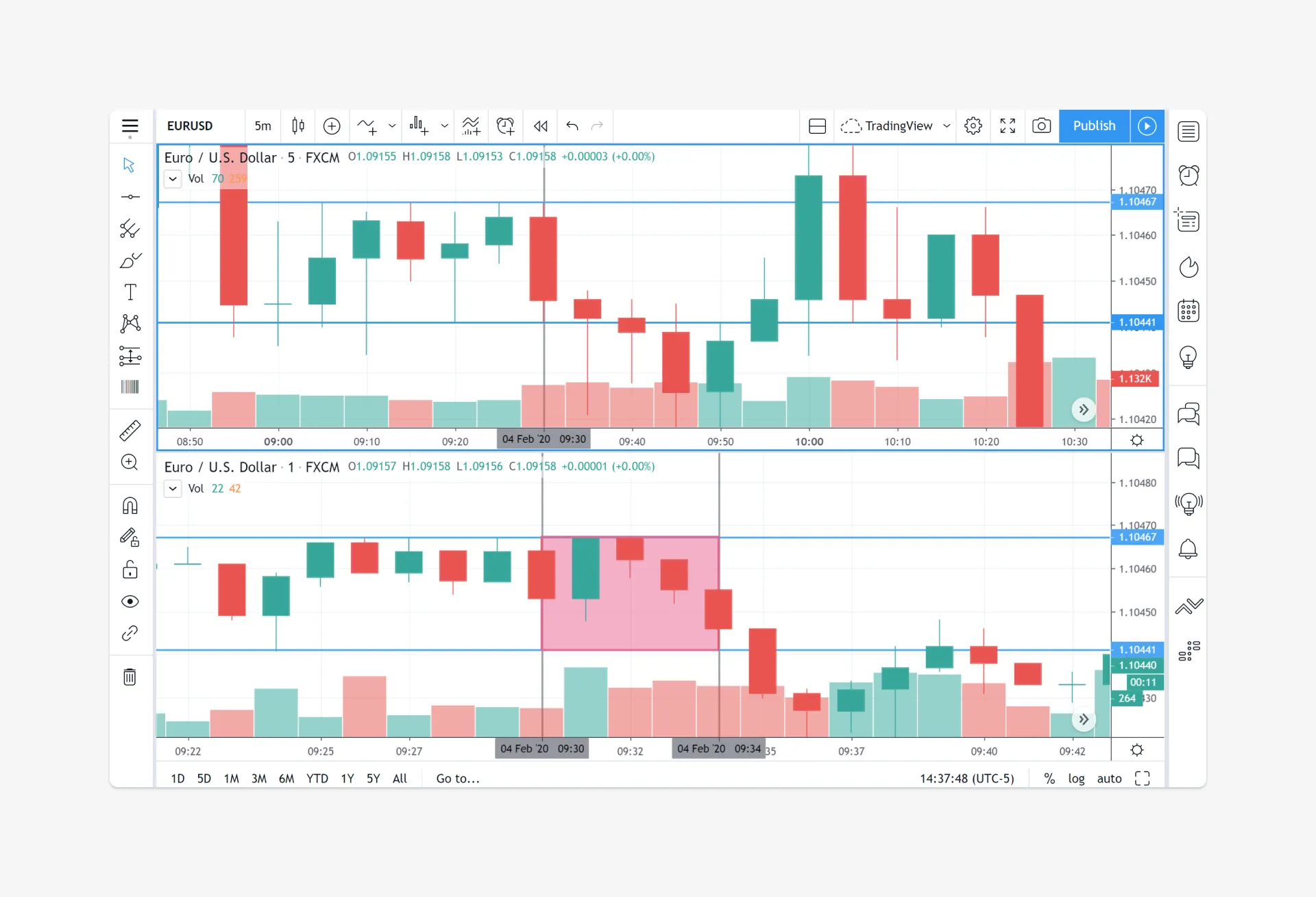Context switching and the security function
The security function enables scripts to request data from symbols
and/or resolutions other than the ones a script is running on.
Let’s assume the following script is running on an IBM chart at 1 minute. It will display the close price of the IBM symbol, but at 15 minutes resolution.

The
security
function’s first argument is the name of the requested symbol. The
second argument is the required resolution and the third one is an
expression which will be calculated on the requested series within the
security call.
The name of the symbol can be defined using two variants: with a prefix
that contains the exchange (or data provider), or without it. For
example: "NYSE:IBM", "BATS:IBM" or "IBM". When an exchange is not
provided, BATS will be used as the default. The current symbol name is
stored in the
syminfo.ticker
and
syminfo.tickerid
built-in variables. syminfo.ticker contains the value of the symbol
name without its exchange prefix, for example "MSFT".
syminfo.tickerid contains the value of the symbol name with its
exchange prefix, for example, "BATS:MSFT" or "NASDAQ:MSFT". It is
recommended to use syminfo.tickerid to avoid ambiguity in the values
returned by security.
The second argument of the security function, resolution (i.e., the
timeframe), is also a string. All intraday resolutions are defined
using a number of minutes. The lowest resolution is one minute and is
indicated by the literal "1". It is possible to request any1 number
of minutes: "5", "10", "21", etc. Hourly resolution is also set
by minutes2. For example, the following lines signify one hour, two
hours and four hours respectively: "60", "120", "240". A
resolution with a value of 1 day is indicated by "D" or "1D". It
is possible to request any number of days: "2D", "3D", etc. Weekly
and Monthly resolutions are set in a similar way: "W", "1W",
"2W", …, "M", "1M", "2M". "M" and "1M" denote the same
monthly resolution, and "W" and "1W" the same weekly resolution. The
third parameter of the security function can be any arithmetic
expression or a function call, which will be calculated in the context
of the chosen series. The resolution of the main chart’s symbol is
stored in the
timeframe.period
built-in variable.
With the security function, users can view a 1 minute chart while
displaying an SMA (or any other expression) from any other resolution
(i.e., daily, weekly, monthly):
One can declare the following variable:
and calculate it at 1 minute, 15 minutes and 60 minutes:
The security function returns a series which is then adapted to the
time scale of the current chart’s symbol. This result can be either
shown directly on the chart (i.e., with plot), or used in further
calculations. The “Advance Decline Ratio” script illustrates a more
involved use of security:
The script requests two additional securities. The results of the requests are then used in an arithmetic formula. As a result, we have a stock market indicator used by investors to measure the number of individual stocks participating in an upward or downward trend.
Barmerge gaps and lookahead
There are two switches that define how data requested with security
will be mapped to the current timeframe.
The first one, gaps, controls gaps in data. With the default value
barmerge.gaps_off,
data is merged continuously (without na gaps). All gaps, if any, are
filled with the previous nearest non-na value. If
barmerge.gaps_on
is used, then merged data may contain gaps in the form of na values.
The second switch, lookahead, was added in Pine Script version 3. The
parameter has two possible values:
barmerge.lookahead_off
and
barmerge.lookahead_on
to respectively switch between the new, default behavior of
security,
and the old behavior dating from Pine v1 and v2.
This example shows the difference on a 5 minutes chart:

The green line on the chart is the low price of an hourly bar that is requested with lookahead on. It’s the old behavior of the security function. The green line based on historical data is displayed at the price level of an hourly low right after a new hourly bar is created (dotted blue vertical lines).
The red line is a low price of an hourly bar that is requested with lookahead off. In this case the requested low price of an hourly historical bar will be given only on the last minute bar of the requested hour, when an hourly bar’s low won’t return future data.
The fuchsia dotted line represents the beginning of real-time data. You
can see that barmerge.lookahead_on and barmerge.lookahead_off behave
the same way on real-time data, i.e., as barmerge.lookahead_off does.
Understanding lookahead
There are many published scripts using the following code:
In this case the close[1] expression fetches the close of the
previous day, so the construction does not use future data.
In Pine v3 or later, we can rewrite this in two different ways, using
barmerge.lookahead_on or barmerge.lookahead_off. If you use
barmerge.lookahead_on, then it’s quite simple:
Because the original construction doesn’t use future data, it is
possible to rewrite it using barmerge.lookahead_off. If you use
barmerge.lookahead_off, the script is more complex but shows how the
lookahead parameter works:
When an indicator is based on historical data (i.e.,
barstate.isrealtime is false), we take the current close of the
daily resolution and shift the result of security function call one
bar to the right in the current resolution. When an indicator is
calculated on real-time data, we take the close of the previous day
without shifting the security data.
Requesting data of a lower timeframe
security function was designed to request data of a timeframe higher
than the current chart timeframe. On a 60 minutes chart, this would
mean requesting 240, D, W, or any higher timeframe.
It is not recommended to request data of a timeframe lower that the
current chart timeframe, for example 1 minute data from a 5 minutes
chart. The main problem with such a case is that some part of a 1 minute
data will be inevitably lost, as it’s impossible to display it on a 5
minutes chart and not to break the time axis. In such cases the
behavior of security can be rather unexpected. The next example
illustrates this:

This study plots two lines which correspond to different values of the
lookahead parameter. The red line shows data returned by security
with lookahead=barmerge.lookahead_on. The blue line with
lookahead=barmerge.lookahead_off. Let’s look at the 5 minutes bar
starting at 07:50. The red line at this bar has a value of 1.13151 which
corresponds to the value of the first of the five 1 minute bars that
fall into the time range 07:50 - 07:54. On the other hand, the blue line
at the same bar has a value of 1.13121 which corresponds to the last of
the five 1 minute bars of the same time range.
Footnotes